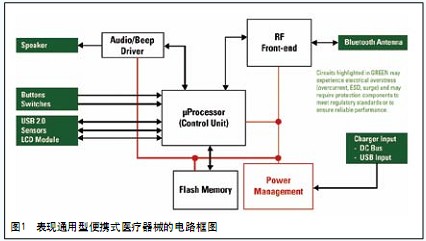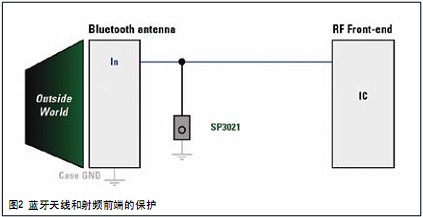Portable handheld medical devices improve patient care both in the medical facility and in the patient's home. Proper use of electronic circuit protection devices is an important part of medical device design to ensure reliability and safety.
Circuit protection is an important design element
Portable medical instruments, such as blood glucose meters, sphygmomanometers, and oxygen meters, can be designed to have communication capabilities to provide continuous communication between the patient and the caregiver at virtually any location. This will hopefully improve patient care at a lower cost, but it will require equipment designers to pay closer attention to reliability and safety issues in their circuit design and component selection.
The use of overvoltage and overcurrent protection components is a key design consideration. The main subsystems that must be considered include communication interfaces, DC input/charging circuits, battery packs, sensors, LCDs, keyboards, and buttons.

Figure 1 is a simplified circuit diagram of a general purpose handheld instrument. The green text box indicates the circuit that may be subject to overvoltage or overcurrent conditions. The remainder of this article will introduce electrical threats and typical solutions.
Since the product will be used by users frequently, the main electrical threat is electrostatic discharge, which is easily generated when the user walks over the carpet. Electrostatic discharge (ESD) can deliver excessive voltage and current to the internal circuitry.
Fortunately, there are a variety of circuit protection devices available to address overvoltage (electrostatic discharge and lightning surge) and overcurrent (short circuit and overload) conditions. For example, adding a self-resetting positive temperature coefficient (PTC) thermistor to a USB port that is typically used to charge a battery provides overcurrent protection on a portable instrument. These devices limit the current when an overload occurs and then "reset" to a low resistance value after the overload condition has disappeared. This eliminates the inconvenience of having to replace the fuse.
For overvoltage protection, the handheld device will not be directly connected to the AC grid, so it will most likely encounter low level (residual) surge events and electrostatic discharge shocks. For these events, it is possible to use space-saving semiconductor technology-based devices. These discrete and array diodes offer low clamping voltages and different form factors to provide multiple design options for protection. This low clamping voltage is an important feature of semiconductor-based protection because it makes it possible to protect today's cutting-edge and easily damaged chipsets.
Circuit protection scheme example
Communication interface protection is a high-priority issue, especially for instrument manufacturers who are striving to meet the Continua Health Alliance's guidelines for interconnecting transmitted data. The first edition of the Continua standard published in 2008 defines a specific version of Bluetooth and USB for wireless and wired transmission of home health care equipment in connection with caregivers. Some examples are provided below to illustrate how these protection devices are applied.
As shown in Figure 1, the wireless (radio frequency) interface of a handheld instrument may be exposed to electrostatic discharge surges caused by its antenna. The circuit in Figure 2 illustrates an electrostatic discharge solution based on semiconductor technology that protects the RF amplifier's RF amplifier input module from electrostatic discharge threats. This protection device is a 0.5pF (to maintain signal integrity) discrete diode that provides a low clamping voltage to protect sensitive RF front ends.

Pre-Filter,Primary Filter,Primary Air Filter,Air Filter Primary
Dongguan V1 Environmental Technology Co., Ltd. , https://www.v1airpurifier.com
![<?echo $_SERVER['SERVER_NAME'];?>](/template/twentyseventeen/skin/images/header.jpg)